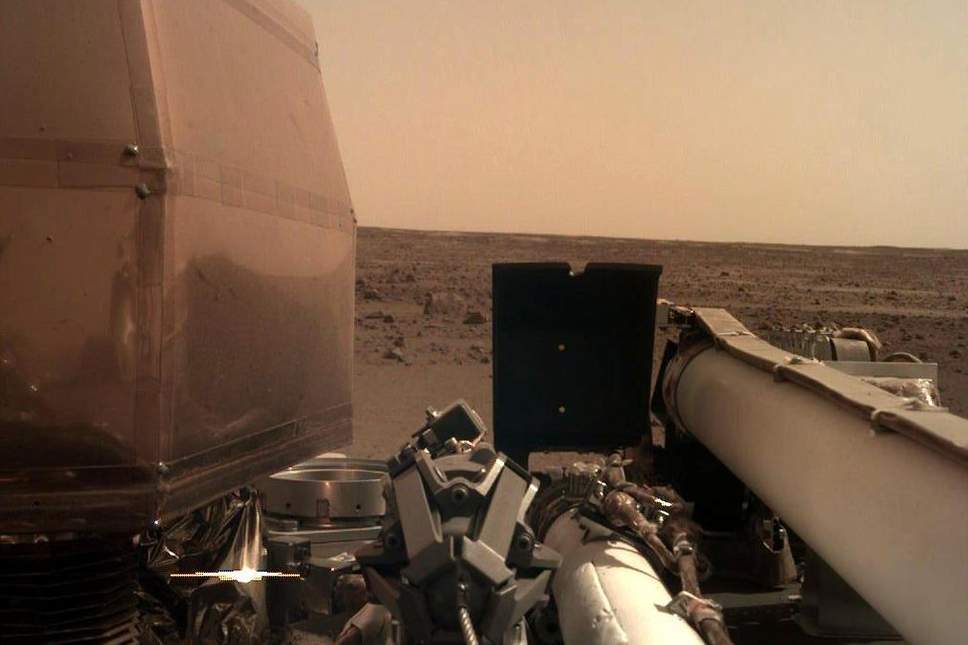NASA lands robotic probe on Mars
November 27, 2018 | Expert Insights

A US-made spacecraft has survived what NASA called “seven minutes of terror” and landed safely on a flat Martian desert, to begin the first scientific investigation of the planet’s interior.
Background
InSight is a robotic lander designed to study the interior of the planet Mars. The mission launched on 5 May 2018 and is expected to land on the surface of Mars at Elysium Planitia on 26 November 2018, where it will deploy a seismometer and burrow a heat probe. It will also perform a series of radio science experiments to complement the studies of the internal structure and rotation of Mars.
This is NASA’s first attempt to land on Mars in six years, and all those involved are understandably anxious. The robotic geologist — designed to explore Mars’ insides, surface to the core — went from 12,300 mph (19,800 kph) to zero in six minutes flat as it pierced the Martian atmosphere, released its parachute, and fired its descent engines for a precise landing on three legs.
Earth’s success rate at Mars is 40 per cent, counting every attempted flyby, orbital flight and landing by the U.S., Russia and other countries dating all the way back to 1960.
Analysis
NASA controllers at the Jet Propulsion Lab in California received a radio signal from the InSight probe just before 8 pm GMT, indicating it had touched down on the Elysium Plantana, close to the Martian equator and 146m km from Earth.
As is customary on such occasions, the JPL control room erupted with cheers, hugs and embraces as the scientists and engineers — all clad in reddish purple shirts — celebrated InSight’s arrival in good shape.
The space agency had first popularised the phrase “seven minutes of terror” in 2012 to describe the safe descent of its last Mars probe, the Curiosity rover, through the thin Martian atmosphere. The technology used for InSight, using parachute and retro-rockets, is slightly different and based on the successful 2008 Phoenix landing. “We’ve studied Mars from orbit and from the surface since 1965, learning about its weather, atmosphere, geology and surface chemistry,” said Lori Glaze, NASA’s acting director of planetary science. “Now we finally will explore inside Mars.”
While previous Mars probes investigated places with interesting surface geology, NASA sent the $1bn InSight mission to the smoothest and flattest place on the planet, where a safe landing was most likely. “It’s taken more than a decade to bring InSight from a concept to a spacecraft approaching Mars and even longer since I was first inspired to try to undertake this kind of mission,” said Bruce Banerdt of JPL, the project’s principal investigator. “But even after landing, we’ll need to be patient for the science to begin.”
InSight’s robotic arm will put its instruments on to the surface over the next two to three months, while scientists monitor the environment and photograph the terrain in front of the lander. They will be helped by a working replica of InSight in a “Mars sandbox” that will be sculpted at JPL to match the actual landing site on Mars so that the team can make sure the instruments can be deployed safely even if there are rocks nearby or InSight does not land fully upright.
InSight’s investigations will use three main research techniques. A seismometer will study ground vibrations set off by “marsquakes” (the equivalent of earthquakes) and meteorite impacts. Second, InSight will sink a probe three metres into the ground to measure temperature and heat conduction. Third, radio transmissions to and from Earth will determine its exact position in space, from which scientists can detect any tiny wobbles in the planet’s rotation caused by conditions deep inside the core.
The next Mars missions, scheduled for launch in 2020 and arrival in 2021, involve separate rovers built by NASA and the European Space Agency.
Assessment
Our assessment is that the successful landing of the InSight lander will mark a significant milestone in humanity’s inter-planetary exploration missions. We believe that the success of the InSight mission will positively impact any future rover missions (manned or unmanned). We also feel that by studying the untouched geology of Mars, the robotic probe could help us in understanding the nature of our planet better and in more detail.








Comments